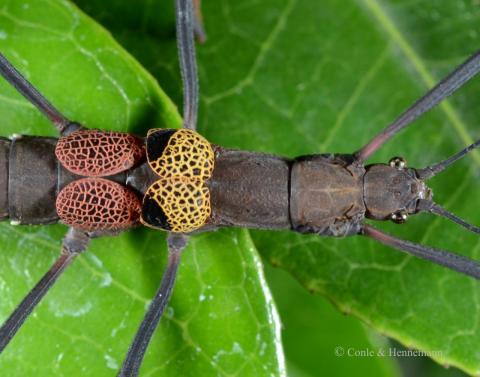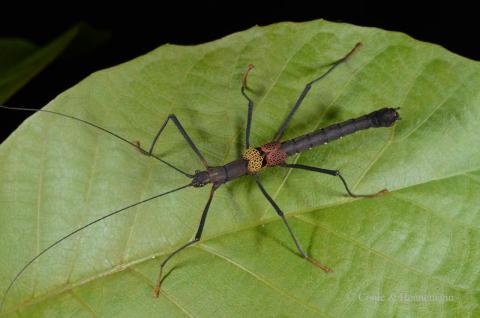
Genus
Species
Stock
CLP
215
PSG
299
Culture status
In culture
Foodplants
Lonicera nitida
Privet (Ligustrum spp.)
Lilac (Syringa vulgaris)
Plantago spp.
Aucuba japonica
Breeding notes
(by Bruno Kneubuehler)
General Notes
- Redtenbacher (1906) first named this species Neophasma subapterum
- O. Conle, F. Hennemann and Guttierez (2011) synonymised Neophasma with Pseudophasma
- 2006 - first successful culture of this species by phasmid breeders in the Czech Republic
_________________
Origin
- Tachira (Venezuela)
_________________
Females
- typical stick insects with colourful small wings, about 6 cm long
- basic colour is dark brown with a white dot on the lateral side of each abdominal segment
- the wing are very beautifully coloured – the fore wings are meshed yellow-black and the hing wings meshed red-black
- feelers are longer than the fore legs
_________________
Males
- typical stick insects with colourful small wings, about 4,5 cm long
- basic colour is dark brown with a white dot on the lateral side of each abdominal segment. But there are also males with a predominantly reddish brown colour
- as in the females, the wing are very beautifully coloured – the fore wings are meshed yellow and the hing wings meshed red
- feelers are longer than the fore legs
_________________
Eggs
- different shades of brown, about 3 x 2 mm
- rough textured surface
_________________
Food Plants
- nymphs and adults accept and grow easily on Lonicera cf nitida (the one which is used as a ground coverer), privet (Ligustrum sp.) and lilac (Syringa sp)
- but they adore plantains (Plantago sp.)
- Aucuba (Aucuba japonica) - is well accepted by all stages (Sarah-Jane Dulitz, Germany)
_________________
Breeding Notes
- easy to breed
- incubate eggs at room temperatures (18 – 25°C) on a damp but not too wet substrate
- incubation time is about 4 months
- freshly hatched nymphs are dark brown with light feeler tips
- they grow up easily at room temperatures, males take some 3 months to mature, females about 3,5 months
- females start to lay eggs some 3 – 4 weeks after their final moult. They lay about 2 eggs a day and just let them drop to the ground
- from the prothoracic glands they can spray a white defensive secretion when feeling threatened. This spray has an strongly acidly smell and probably causes a (non-permanent) burning sensation when it comes in contact with the mucous membranes in the mouth or in the eyes. Thus one should be careful when handle them
- males tend to stay permenantly on a females back. But it is not so difficult to separate pairs, as it is for example in Anisomorpha species
- during the day they do not rest on their food plants, but rest on the side of the cage – preferably in a darker place















